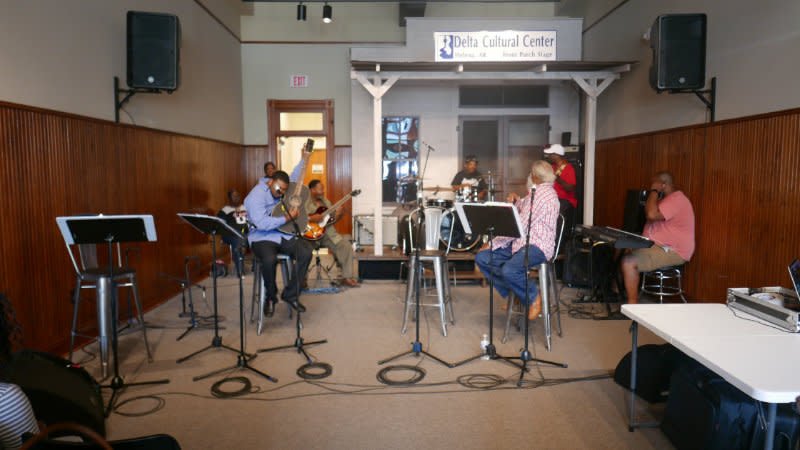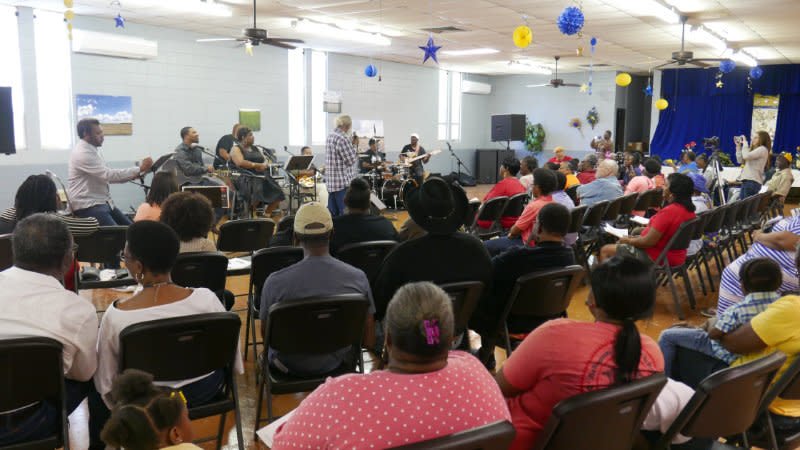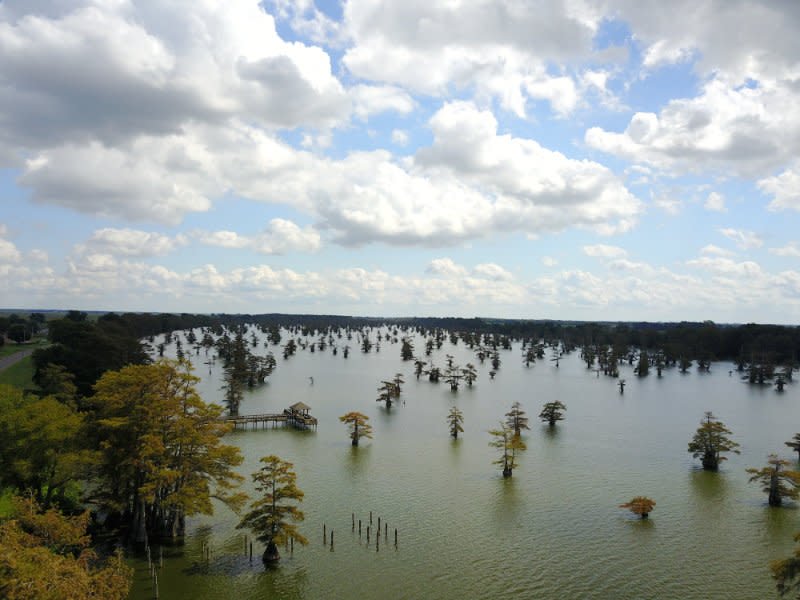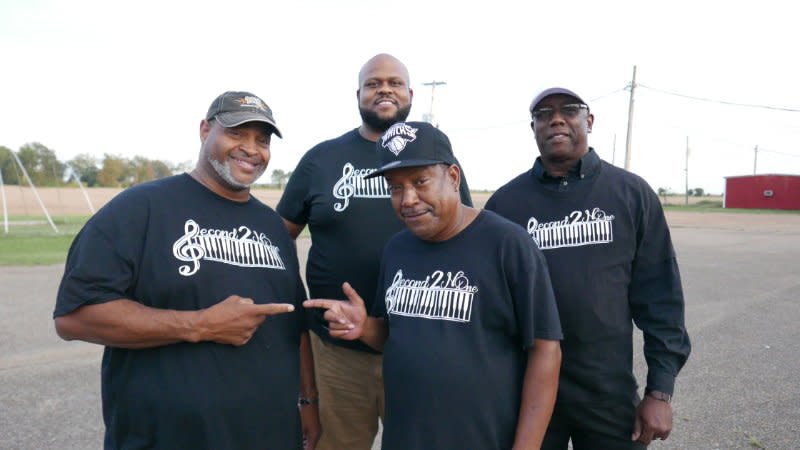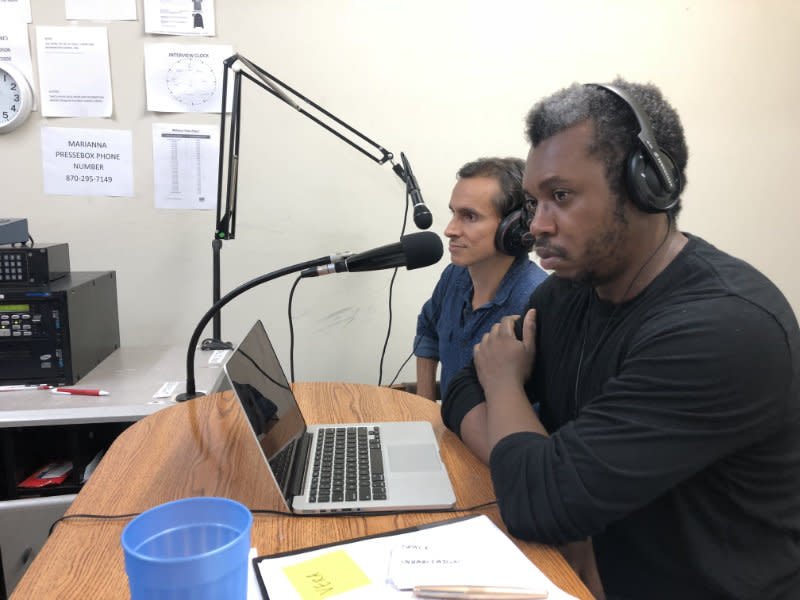NET/TEN Shareback: Notch Theatre Company & Delta Cultural Center - Reflections on Black 'n da Blues
Notch Theatre Company (New York, NY) and Delta Cultural Center (Helena, AR) partnered on the first residency for Remember2019, an ensemble project created to reflect on and respond to the history of lynching in America. In a series of six artistic residencies over the next six years, Black cultural workers in the Arkansas Delta will create performances around topics of self-determination, memory, and reflection as related to the mass lynching of 1919. Titled Black 'n da Blues, the residency gathered local blues musicians to collect stories and create performance around the question: where’s hope in the Blues?
SHAREBACK:
Initially I pitched sharing the presentation materials that we developed with our community partner during this grant process and which we presented at the National Performance Network’s Annual Conference and to the Children’s Defense Fund Child Advocacy Conference. While NET felt those materials too broad for this particular shareback, they have been a huge boon in sharing our methodology/work with the field and we greatly appreciate the time and space and resource NET afforded us to be able to collaboratively build them during this process. Thank you for that!
Included here, I have tracked down the initial notes our main artist wrote about his experience and questions of the process, which is a much more intimate and specific experience of the work. I hope our learnings and hurdles as detailed below will be helpful!
Additionally, I have included the link to a video with community testimony from the process. Please don’t hesitate to reach out with any questions or for additional information or materials.
--Ashley Teague, Notch Theatre Company
Reflections on
BLACK 'N DA BLUES
Reflections about the process:
It went smoothly - there was a sufficient dreaming period and construction period. There was a limited revising period - a longer process would’ve resulted in more revising (discoveries were made that didn’t have enough time to fully realize themselves). We had sufficient rehearsal time when we started but there could’ve been less rehearsal as the process went along.
We had questions about how much time and space is necessary to do more than just ‘meet folx where they are.’ We were asking folx to bring themselves and their histories and the container we created didn’t account for how those experiences/philosophies/values met us in this contemporary moment.
We felt like we made space for people to speak from their truths as they relate to the history and the music of the county. We wondered how we could’ve made the time and space to challenge those truths from our different perspectives. Questions about when individuals and their stories reflect misogyny or homophobia or Christian conservatism.
I found myself asking - where is the space to challenge this persons truth? But that wasn’t a part of the journey or mission of the work. We were asking folx to bring their selves and their histories and the container didn’t account for how those people met this moment. We contained it so that there was protection from the public.
What does the invitation look like? Our curator said: Meeting people where they are is one thing - I don’t feel like we co-signed anything...that is longer and deeper work than the time or space allowed for. We weren’t screening for it. I found myself wanting to talk to other makers about where and when they locate themselves as author, witness, listener, in a process like this one
I appreciated that Carlos (our curator) centered the work around Hush Harbors and the testimonials of Ida. B. Well’s as both of those seemed to bring new perspectives to the history of the event and the culture that even local folks were not familiar with. Furthermore, it was a big contrast to what was centered during Robert Whitaker’s presentation the week before. The difference being reflected in feedback our local partner’s appreciation for the piece: “Thank you all so much for the work that you've done in the Phillips County area to help bring awareness to this aspect of our history in as positive a light as possible. The basis of spirituals and blues is the harmonious release and historical account of perils and plight; singing for freedom while passing down the history of trials and tribulations faced.”
We learned a lot about what locals think makes for good ‘marketing’ in the community. Organizing grassroots word of mouth campaigns are the best way to go and finding various ways to spread that word of mouth, community doesn’t simply show up because of the credibility of the institution or their commitment to the individual or organization doing the inviting. They will show up because of their excitement for the show. Relying on partner marketing isn’t our best option.
One community partner suggested that a) our advertisements were too “New York” and that b) we chose the wrong individuals within the community to helm marketing efforts. (Here we discovered some internal drama that was difficult to navigate as an “outsider” or avoid)
The information I was receiving from local partners about who and when folx were coming was somewhat inconsistent.
I have questions about the most effective use of a press release. Even though we heard that our exchange partners, Delta Cultural Center, released the information far and wide through their broad network, we weren’t able to get any attention from the press like we did with our last program here (Scapegoat.) That might be because there is a different person running the marketing department at the DCC or that might be because of when the press release was made and shared - during Scapegoat the release was shared almost a month in advance of the event versus with Black ‘N Da Blues where it was only shared within a week of the event.
We know that folx saw our flyers and that folx heard us on the radio. There is always room to do more of that and through other social groups such as churches, community centers, organizations, etc.
We learned that musicians like to get paid in cash. We learned that the artists need a printed calendar and then daily text reminders about their rehearsal schedule. For this, it was very useful to have a printer in the house.
We learned that gas money is more important than money for housing so we need a large amount of petty cash.
LaPearl (our local coordinator) was a perfect fit for the project. She was very proactive and organized. She didn’t drop a ball and was very willing to meet in person or over the phone and she always returned a call or chat. She was excited about organizing the story circles and she was excited about the turnout in Marvell. How do we give her more to do? And lean on her more? She expressed an excitement to do more of this work. “What you all got next?” So what do we have next for LaPearl? Mo did a wonderful job training and developing a shared vocabulary - now that we have that she might have more ease. While the cause/mission is still growing on her, I know she’d be happy to work with us again and would be able to contribute ideas about how to be more effective the second time around.
DCC was interested in having some student showings and I think that if we are going to do student audiences in the future we might be better off going to the schools to perform, rather than busing them to us. Either way, I believe it would’ve benefited us to reach out to the schools way earlier than we did.
I was nervous about how the material would be received by young audiences and their teachers, administrators, parents. There was a part of me that wanted to invite more teachers, administrators, parents into a workshopping process to make sure that the piece was going to effectively reach young audiences. Along the way I checked in with our local friends with kids and everyone seemed positive about the show and the way we were sharing the story of the massacre. That written, I do not know how the students received the information. We had initially expressed interest in doing school visits before shows but that fell off the radar and quite frankly, it would’ve been too much for our team to handle. That written, I do think it would be good for us to do pre and post visits to schools to talk about the material. I’d also be interested in preparing teaching guides to support the show.
I’ve got a lot of appreciation for the work that our documentarian did. He captured loads of material that I believe will help us elevate the way we share our story. Separately, I would’ve liked to have done a better job at introducing our documentarian to the culture of our work and our community. What we are doing and the way we are doing it is really really really specific. There were a couple of moments where the documentarian made choices that were outside the boundaries we have established for ourselves in this project and those might’ve been avoided had I been better at welcoming him into our space. That has me thinking about how we bring anyone into our work - being artists or co-producers, no matter the community they come from.
It would’ve been good to spend more time thinking more broadly about the potential future for the piece that DCC, the community and we made together. I was so concerned with making sure that folx in Phillips County saw it that I didn’t think about inviting other presenters/producers in the case that others might be interested in seeing it as well. Although we did get a potential presenter to visit the show and I got several requests to see our promotional material, I didn’t start doing that until 9 days before the show and I believe I could’ve done a lot more to get folx out had I started sooner.
Debrief on Outcomes:
Of what we spent, 51% was spent on community ; Total rehearsal hours: 40.5; Total story circles: 3; Total interviews recorded: 18; Met with over 45 individuals over the course of those interviews and story circles; Total flyers passed out: 400 and 11 yard signs! ; Total radio shows: 4 (twice on KFFA, once on Delta Force 3, once on King Biscuit Time)l Total performances: 4. One in Marvell, one in Elaine, two in Helena ; Total audience members: 205 - 65 in Marvell, 35 in Elaine, 60 at the morning show in Helena, and 45 at the afternoon show in Helena, ¼ and ⅓ were returning audience members. ; Total artists commissioned: 12 ; Total Technical staff: 4
Responses to the event:
Carlos: What is exciting is the level of enthusiasm that was articulated to us - of wanting to see more relatable cultural production. The audience was excited to see itself reflected back to them. Placing those musicians in relationship to each other doesn’t always happen in performance and that was a powerful moment. Everyone expressed that they had learned something that they did not know. Credibility went up in the eyes of our partners. People outside of our partner circle know who we are and are proposing ways of collaborating with us.
LaPearl: Thank you all so much for the work that you've done in the Phillips County area to help bring awareness to this aspect of our history in as positive a light as possible. The basis of spirituals and blues is the harmonious release and historical account of perils and plight; singing for freedom while passing down the history of trials and tribulations faced.
Lisa Allen, Operations Director at the Stax Museum in Memphis: The show was truly a moving experience and I'm so thrilled I made the trip. I can't thank you enough for the invitation.
Danny Bell: This project is wonderful, its moving. I consider myself I’ve been to Elaine a thousand times and I never knew that happened. I’m proud to be a part of it.
Mike Boone - my expectations was to play music by James Morgan but when we first practiced it in Marvell and saw it all come together, it was bigger than what I thought it was. I mean I’ve just heard Elaine massacre, Elaine race riots but just never knew actually.. its my first time near ida b wells’s name - what she actually did - and so its much more than music, but it is music.
Rose Tate - Black 'n da Blues was a great experience for me…I would tell them that it would be so great if they could go and hear the history and the music it would be such a great experience. Our kids don’t know where the blues originated from and they don’t know anything about the Elaine riot, so really we’ve got history all the way around in music and what happened way back in communities…
Rev Turner - I enjoyed it, I really did. I think that its a necessary, its a very thought provoking project. Its a very thoughtful project to make those of us who live in Phillips County think about what the past has been. To think about what our ancestors had to go through in order to be citizens of of Phillips county or to be citizens of America. This project brings back a needed memory for us in today’s society. Because as we look to go forward we may repeat somethings if we don’t know where we came from. Its a project to truly educate people and to get people to think - thinking whether or not you agree with the material or how it is portrayed by the artists or producers of the show. it will make you think that something happened.
Great Grandmother of one of the performers: My favorite part was my granddaughter - she was my favorite part - I was glad she was in it - because so many kids don’t know where their heritage started…
Dr. Olson - You are bringing together raw talent you art from here - maybe not young in age but young in exposure - people whose voices are as good as the voices in Hollywood. But you worked with them to bring it to a show - thats the most important thing you did about it. The working of bringing together 1919 and the blues is a creative way of bringing together people who can enjoy it without having to read or write, just feel it. I think its a very powerful way to bring the feelings out and from that I would expect it to generate both more consciousness and more conversation. Black 'n da Blues is a narrative in music plus music plus narrative that brings the best out of the feelings of the delta. It gives pride in the delta, joy in being part of the concert and I’d encourage everyone to come and see it because its delta bred its delta born it is of Elaine.
James White - the show is real educational. I really think ya’ll should take that further because the kids need to understand . They don’t have no body to teach them what’s going on so that show just took you from my childhood all the way to now. What people go through how they feel. So thats something the kids need to learn. Black 'n da Blues is something that everybody in the south needs to know maybe even up north. It’ll take you for a ride, all you have to do is pay attention. It’s a show that’ll have you hooked! It’ll have you hooked - I think everybody should see that show.
Beatrice Shelby - it was a great experience. We thought it was about the blues, we didn’t know it was about the history bringing together the blues and church songs - it was a magnificent experience for peoples and I just really liked how the young folks that were there were interacting and I liked how the older people talked about it afterwards. If you came to look a t the show you can understand history in the making how history is documented and you can really understand what part blues played in the lives of folks in the delta - its a history lesson.
Turner - I really think that people worked on the project and took part in it, they done a wonderful job and they need to be complimented - I think they sung songs that were relevant to the time and the era and they put their heart and passion into singing those songs and they had a story behind why they singing those songs.
Reflection on how we upheld our values:
Sharing Stories - all over the place.
Cultural Specificity - reflected in the rehearsal process
Culturally specific histories - that’s exactly what the show was -
Moral Fundraising and Fund Management: 51% of what we raised was spent on subcontractors, local housing, local catering, local venues, etc. Complete transparency with our partners on our budgets. Donating our purchased equipment: artwork, music stands, recording devices, stools to local partners.
Transformative Justice: The performers regularly reflected how changed they were by the project and their new found awareness of what happened in Elaine.
Intergenerational Collaboration: From 10 year old Mariah through 71 year old James Morgan.
Moral Imaginary: Focusing on the impact of the Hush Harbor and inviting folx to think about contemporary Hush Harbor - Black ‘N Da Blues as a Hush Harbor
CONTACT INFORMATION:
Photos:
Links:
BLOG

